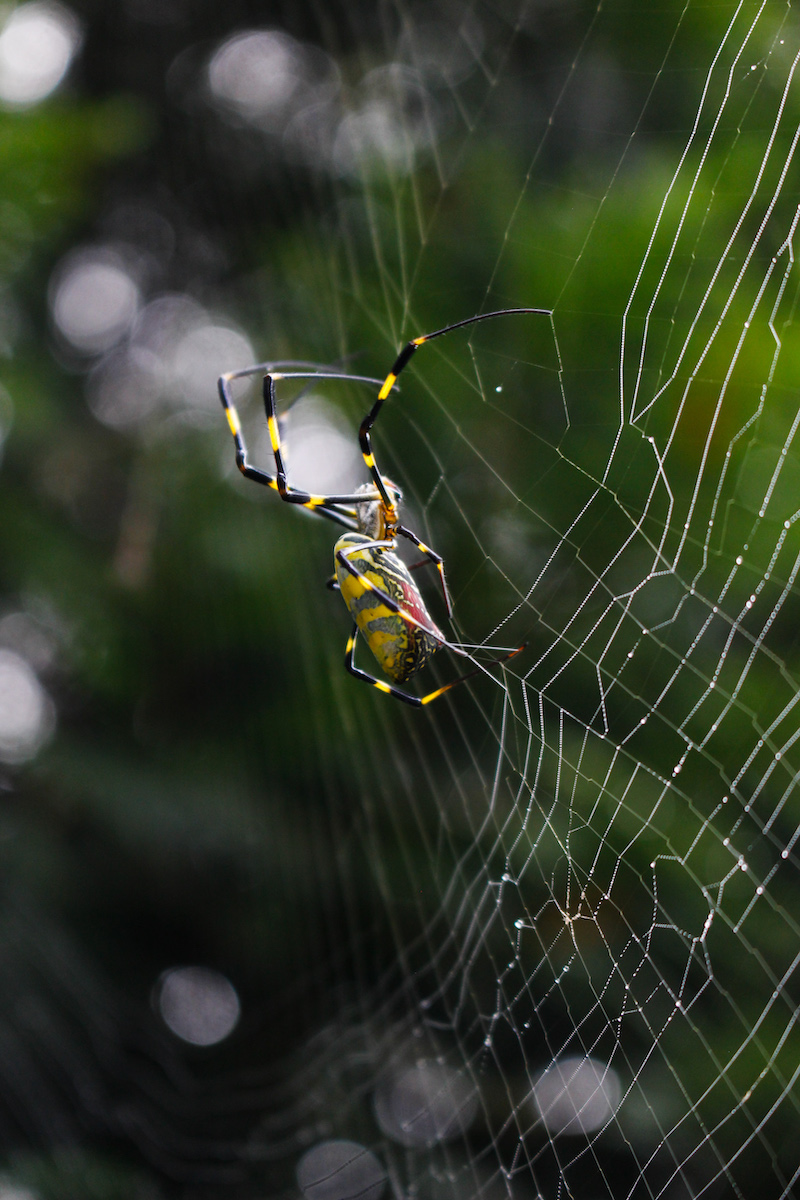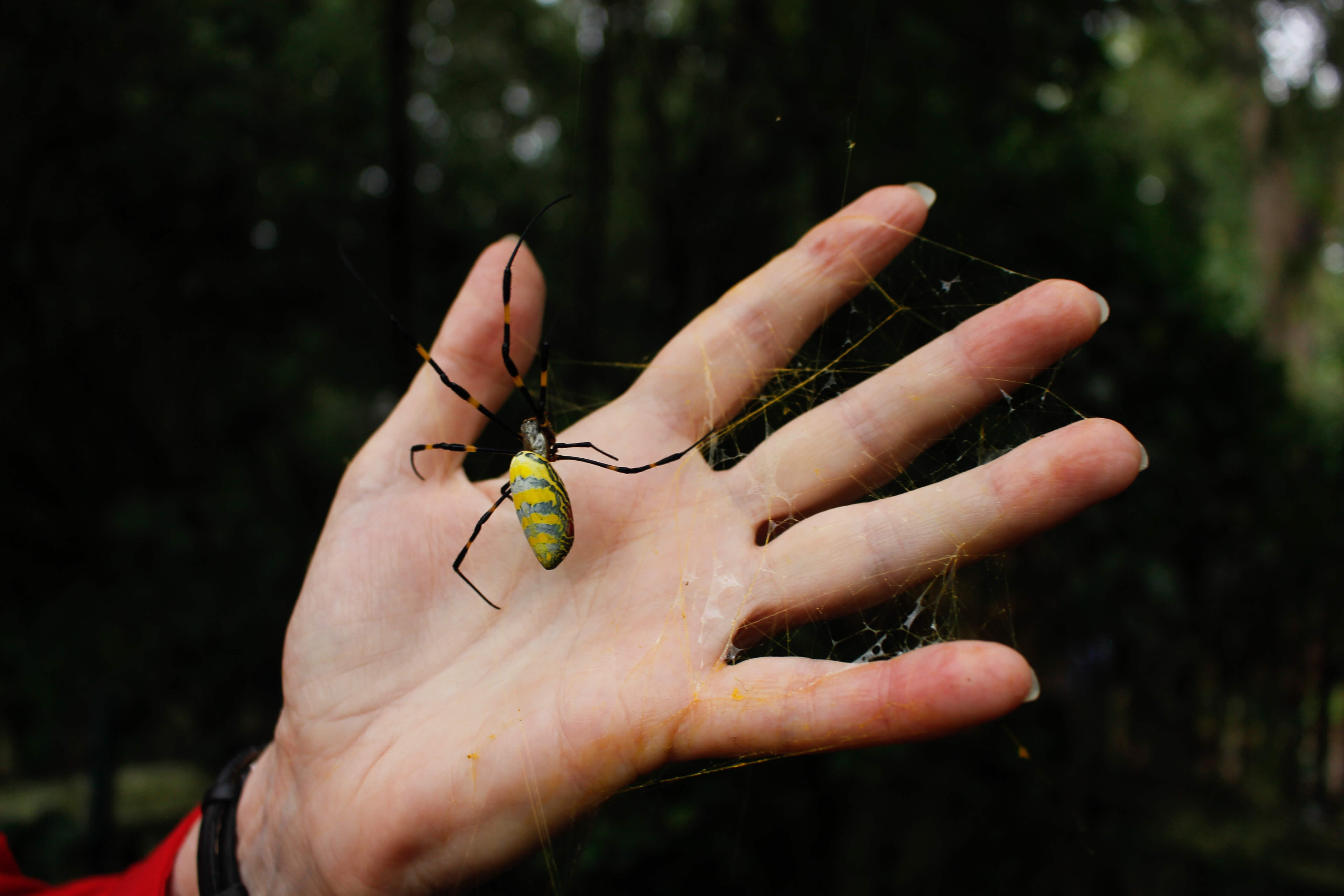
They have been described as palm-sized, parachuting creatures with the potential to spread up the East Coast. Now dozens of webs are appearing in trees, on fences and in gardens around the Southeast, and social media and neighborhood message boards are buzzing with Joro spider sightings. Discussions of eradication methods ranging from chemical sprays to “Joro sticks” — typically a broomstick or other long stick used to destroy or relocate the Joro spiders’ large, strong webs — are rampant. Joro season is undoubtedly here.
But, according to a team of University of Georgia experts collecting data about the spiders through the newly formed Joro Watch initiative, it’s best to put down the stick (for now) and pick up a camera.
“Our native spiders are out there in similar developmental stages, building webs and eating insects,” said Jason Schmidt, associate professor in the Department of Entomology at UGA’s College of Agricultural and Environmental Sciences (CAES). “Spiders consume a lot of different prey types, from flies to pest insects. Removing any spider or attempting to indiscriminately or accidentally remove or control all spiders will damage the biodiversity out there.”
Multidisciplinary team has a united goal
The Joro Watch project will jumpstart an online monitoring program to collect data from the public that can be used for awareness, education and to better understand the current spread and distribution of the arachnid.
The growing, multidisciplinary Joro Watch team includes Schmidt, Rick Hoebeke and Will Hudson from the Department of Entomology; Rebekah Wallace and Joseph LaForest from The UGA Center for Invasive Species and Ecosystem Health; Kamal Gandhi, Brittany Barnes and Priscilla Smith from UGA’s Warnell School of Forestry and Natural Resources; and Erin Grabarczyk from Valdosta State University.
Andy Davis, assistant research scientist and graduate program faculty at the UGA Odum School of Ecology, has studied the spider extensively and agrees with the Joro Watch team on the risk to native Georgia spider populations. He adds that the orchard orbweaver, whose spiderlings look astonishingly similar to Joro spiderlings, are especially abundant this year. Even as a scientist, the distinctions at this developmental stage are tricky to discern.
“If I were to go out and squish every spider now, I’d probably be squishing just as many native species as Joros,” Davis added. “And if people are committing to chemical means, you are not just killing the spiders, you are killing insects. (Chemical pesticides) can also harm humans in addition to our environment” by spreading beyond the treated area on your or neighboring properties.
The rise of the Joro in Georgia
CAES entomologist Rick Hoebeke, associate curator of the UGA Collection of Arthropods at the Georgia Museum of Natural History, remembers the first Joro-related call he received in 2014 — a private resident had collected a spider in his Madison County yard and believed it was a non-native species from Southeast Asia.
“It was like nothing I’d seen before; he was absolutely right,” Hoebeke said. “We worked with a reporter at the Athens Banner-Herald and put down my email for people to report if they’d seen them. I was inundated with emails in late 2014 and have been receiving them ever since.”
The Joro spider likely arrived in Georgia — some report as early as 2013 — by traveling or laying egg masses on shipping containers. In a 2015 paper, Hoebeke wrote that the spider appeared heavily in the area surrounding Braselton, Georgia, on Interstate 85, an area laden with distribution centers.
“One egg mass can contain 500 to 1,500 spiders,” Hoebeke said. However, not all of those will make it to adulthood.
“Many of the eggs do not survive, as the spiderlings eat each other before dispersing or when no food is available,” Schmidt added.
As with other non-native species that have established in the area, Davis said it takes time for the environment to adjust to the new species and vice versa.
“There’s a cousin of the Joro already here in the Southeast: the banana spider or golden silk spider,” Davis said. “They’ve been here for a long, long time — so long that the ecosystem has caught up and they’ve balanced themselves out. There could very well have been a big explosion when they arrived as well. That’s where we could be in the future.”
Hoebeke concurs, “Only time will tell if (Joro spiders) remain at such high numbers. We’re learning as we go.”
Working with the public to find answers

Familiarity with Joro spider development, it turns out, is a challenge even for the experts focusing on researching the showy arachnids, and likely much more so for homeowners and nature lovers simply observing their surroundings.
“Over time, as they continue to grow and molt, the body colorization changes. You don’t really start seeing the distinctively colored spiders as we have come to know them until they reach sexual maturity in the fall,” Hoebeke said, adding that maturity dates range from late August into September. “Up until that time, you have to be familiar with the juvenile forms.”
Rebekah Wallace, Early Detection and Distribution Mapping System (EDDMapS) coordinator at the UGA Center for Invasive Species and Ecosystem Health, said well-meaning citizen-scientists can get a little overzealous despite having limited knowledge on the arachnids.
“There have been studies where citizen-scientists and experts both look at photos of a specific species, yet the experts will report less confidence in their identification,” Wallace said. “It’s because they know how much more can be out there.”
With the number of species out there and possible visual similarities between them, identification can be difficult, Wallace added. Entomological experts consider all these factors when identifying a subject.
“We don’t know for sure if they will or won’t have an ecological impact,” said Kamal Gandhi, professor of forest entomology in Warnell.
The Joro Watch team is pursuing a number of approaches to Joro spider research, looking into their impact on native species (like pollinators and native spiders), habitat, lifecycle and management. Until more research can be completed, all of the experts ask that the public be patient and help gather critical research data by monitoring spider populations in the environment.
“A lot of these spiderlings are hard to distinguish from each other,” Gandhi said. “We recommend not killing every spider. Wait and watch. Of course, if it’s in your path, remove it. But if it isn’t, leave it until you know for sure.”
The power of citizen-scientists
Schmidt encourages the public to get involved with ongoing research through the Joro Watch initiative, where individuals can report Joro spider sightings. Much-needed photos of potential Joro spiders will help scientists learn more about their development, web-location preferences and potential impacts to the environment.
As spiderlings mature, researchers are collecting images and specimens every two to three weeks to follow development and gain insight into what the future holds for the Joro spider in Georgia and beyond, said CAES entomologist Will Hudson.
Hudson fears that “Joro-mania” will cause hyperawareness and militant spider-hunting among the general public.
“That would be devastating for our native web spiders that are usually present in much lower numbers,” Hudson said.
Wallace, who manages more than 300,000 images of varying species in the Bugwood Images Database, said most reporting of Joro spider sightings over the past several years has taken place in August through October. They encourage the public to start reporting in late summer once the spiders begin to reach maturity.
Schmidt and Davis agree that Joros provide an opportunity to teach about spider behavior, an opportunity that can be more challenging with some native spiders that hide in leaves or have camouflage colorations.
“Observe the web and things inside the web. What is she doing? Are there any other spiders in the web? Take some pictures,” Schmidt suggested.
While many people have a deep-seated fear of spiders, Davis said much of it is learned fear, adding that children are not typically innately afraid of spiders. He said that the Joro spider offers an opportunity to overcome arachnophobia due to the species’ timid nature and their tendency to stay in one place over long periods.
“Get to know the spider — give it a name, teach your kids what they do,” Davis said. “There is a great, untapped opportunity here for Joros to teach kids — and adults — to break the cycle of arachnophobia.”
For more information on the Joro Watch initiative or to submit a Joro spider sighting, visit jorowatch.org.
Joro Spider Awareness Day, an event previously scheduled for Oct. 1, has been canceled due to the effects of Hurricane Ian. In its place, the Joro Watch team encourages the public to participate in a virtual Joro Spider Spotting Contest, running Oct. 9 to 15. Participants will be eligible to win custom Joro Watch stickers for the most verified accurate reports, first county report and more through jorowatch.org.
Visit @UGA_CAES on TikTok to learn about how to submit a Joro sighting report and how researchers are educating the public about Joro spiders through UGA Cooperative Extension.
To learn more about the Joro from UGA Extension specialists, visit extension.uga.edu/publications.






